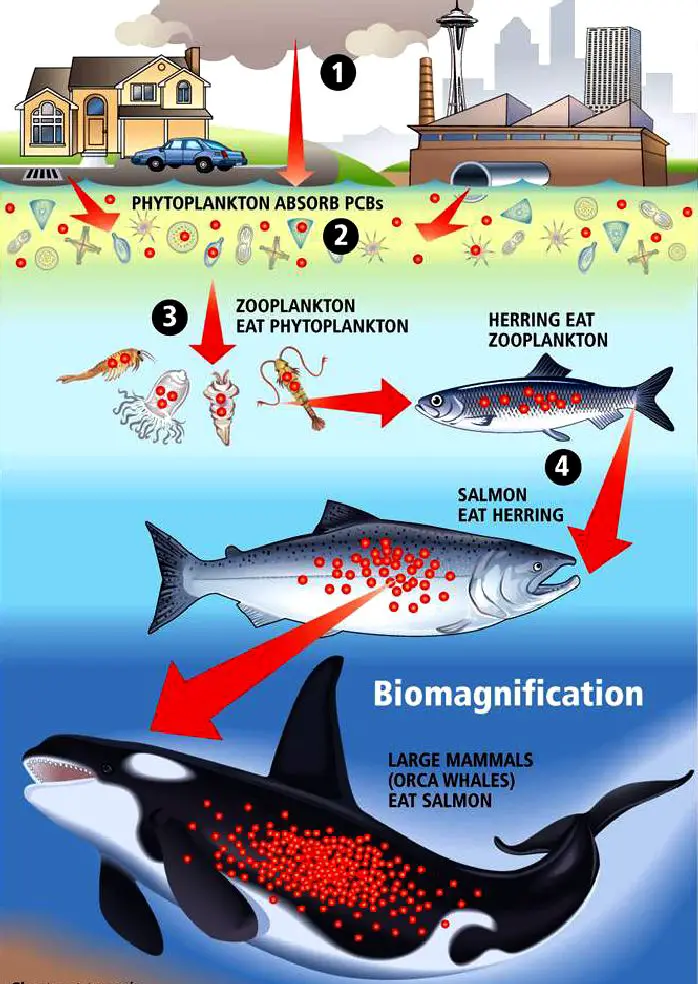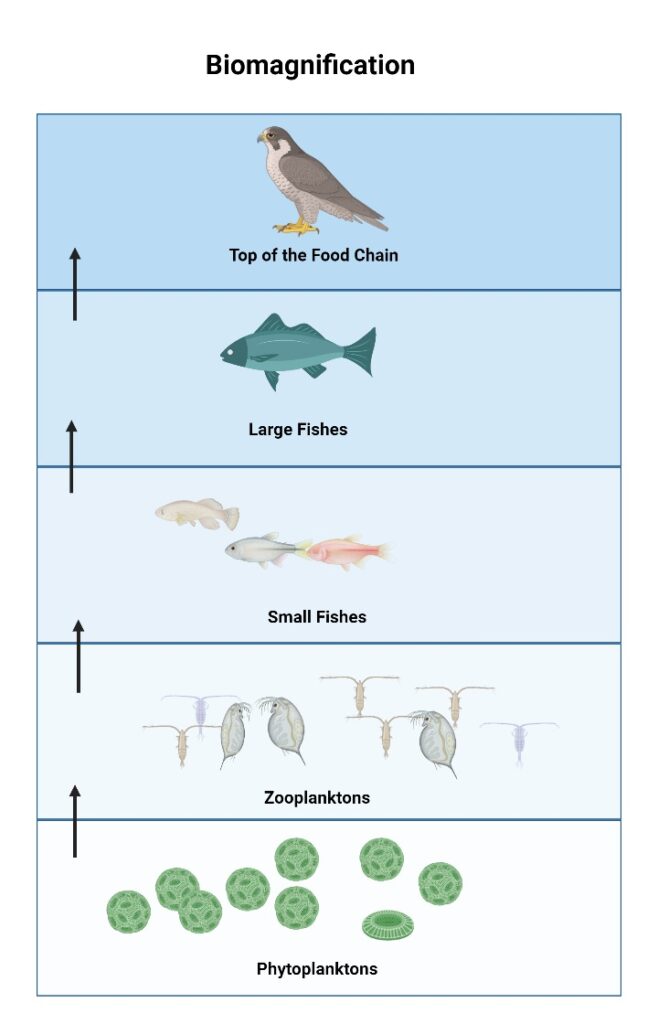Advertisements
Table of Contents
What is Biological Magnification/Biomagnification?
Biomagnification or biological magnification is the process by which certain chemicals accumulate in living organisms to a greater concentration than in the non-living environment.
- Biological magnification, also called bioamplification or biomagnification, is when a toxin, like pesticides, builds up in the tissues of organisms that can handle it at higher and higher levels in a food chain. This growth could be the result of:
- Persistence – when a substance cannot be decomposed by natural processes
- Food chain energetics – when the concentration of a material increases as it goes up a food chain
- The chemical has a low or nonexistent rate of internal breakdown or excretion, primarily due to its insolubility in water.
- Biomagnification can be defined as the rise or increase of contaminated substances as a result of an increasingly harmful environment.
- Contaminants may include heavy metals like mercury and arsenic, as well as pesticides like polychlorinated biphenyls and DDT.
- These chemicals are absorbed by organisms through their dietary consumption. When species higher in the food chain consume organisms lower in the food chain that have certain poisons, these toxins accumulate in the higher organisms.
Causes of Biological Magnification/Biomagnification
The principal causes of biomagnification are as follows:

1. Agriculture
- Pesticides, insecticides, fertilisers, and fungicides used in agriculture are extremely harmful and are released into the soil, rivers, lakes, and oceans.
- These chemicals contain trace levels of mercury, arsenic, copper, lead, and cadmium, among other heavy metals.
- These are hazardous to the health of aquatic species and humans.
2. Organic Contaminants
- Industrially processed manures and biosolids contain pollutants such as medicines and personal care items.
- These compounds have a negative impact on human, animal, and wildlife health.
3. Industrial Activities
- Toxic compounds are emitted into the earth, lakes, oceans, and rivers by industry and factories.
- The gaseous emissions contaminate the environment, which then enters the food chain and causes biomagnification.
4. Mining Activities in the Ocean
- Metals such as zinc, aluminium, cobalt, silver, and gold are extracted from the deep sea through mining activities.
- The mining process produces a substantial amount of selenium and sulphide, which accumulates in water and devastates oceans and coastal regions.
- The degree of toxicity has risen. The aquatic species that are higher on the food chain ingest these poisonous compounds.
Process of Biological Magnification/Biomagnification
- Biomagnification occurs when harmful chemicals and pollutants such as heavy metals, pesticides, and polychlorinated biphenyls (PCBs) compounds go up the food chain by passing through the environment and into the soil or water.
- There, they are consumed by aquatic organisms or plants, which are subsequently consumed by animals, humans, and huge birds.
- Due to the fact that these substances are slowly removed or digested, their concentration within organisms increases as they ascend the food chain.

1. Release of Toxic Chemicals & Pollutants Into the Environment
- Toxic chemicals and contaminants are released into the environment, eventually contaminating soils, rivers or lakes, and oceans.
- The concentrations of these hazardous chemicals and pollutants discharged into diverse habitats appear to be fairly modest.
- Even with regard to weight, they are little.
2. Entry of Toxins Into Phytoplanktons
- Phytoplankton are tiny plants that float in the ocean and absorb contaminants.
- Toxins are absorbed and persist in the tissues of the body without being removed or degraded.
- Toxins can build up to 200 parts per trillion over time, a fourfold increase in toxin accumulation.
3. Entry of Toxins Into Zooplanktons
- The term zooplankton refers to small marine organisms that float in the water.
- They consume phytoplankton and as a result absorb the toxins.
- Toxins become stuck in an organism’s tissue and are not removed or broken down.
- Over time, the toxin concentration grows to two parts per billion, a tenfold increase from the initial concentration.
4. Consumption of Zooplanktons by Small Fishes
- When small fish eat zooplankton, they absorb the toxins.
- They are then absorbed by their fatty tissues.
- As a result, concentrations increase to around 20 parts per billion, a tenfold increase.
5. Consumption of Small Fishes by Larger Ones
- When giant fish graze on smaller fish for nourishment, the poisons that build in their fatty tissues are consumed.
- Until concentrations reach 80 to 100 parts per billion, they rise.
- The harmful levels have quadrupled or quintupled.
6. Organisms on Top of the Food Chain
- When gigantic fish are consumed, species at the top of the food chain, such as dolphins, seabirds, and humans, collect toxins in their tissues, such as the liver.
- In this region, the maximum concentrations range from 10,000 to 15,000 parts per billion.
- Since the consequences interfere with the proper functioning of vital organs, the animals’ fertility and susceptibility to infection are compromised.
Effects of Biological Magnification/Biomagnification
1. Impact on Human Health
- Mercury, cadmium, lead, cobalt, chromium, and other chemical toxins increase the risk of cancer, liver and kidney failure, respiratory disorders, birth defects in pregnant women, brain damage, and cardiovascular disease.
- For instance, mercury and polycyclic aromatic hydrocarbon-contaminated seafood consumption has been related to hepatitis and cancer (PAHs).
2. Effects on Reproduction and Development of Marine Creatures
- The accumulation of toxic compounds and components in the vital organs of aquatic species has a negative effect on their reproduction and growth.
- Seabird eggs, for instance, have shells that are thinner than usual, which can result in the birds shattering their eggs instead of incubating them.
- By harming their reproductive organs, selenium and other heavy metals, such as mercury, have a deleterious effect on fish reproduction.
- Moreover, PCBs (polychlorinated biphenyls) are found in high amounts in aquatic systems, where they biomagnify and inhibit reproduction.
3. Destruction of the Coral Reefs
- The use of cyanide in gold extraction and fishing harms coral reefs.
- Numerous marine organisms use reefs as breeding, feeding, and dwelling grounds.
- Destruction of aquatic creatures threatens their continued existence.
4. Disruption of the Food Chain
- Many aquatic animals depend on the natural food chain for existence.
- When chemicals and other pollutants are carried into soils, rivers, lakes, or oceans and ingested by a variety of organisms, the intricate connections within the food chain are disrupted.
- It occurs when small animals consume or plants absorb harmful elements, which are eventually absorbed by larger creatures, negatively affecting the entire food chain.
- Humans and animals at the top of the food chain may consume infected animals or plants, placing them at risk for illness, reproductive issues, and even death.
Examples of Biological Magnification
Example 1
- When pesticides are sprayed to suppress mosquito populations, a trace quantity of DDT is released and accumulates in the cells of many aquatic organisms when the water is combined.
- Feeders in the food chain, such as fishes and clams, take DDT when they consume these species. In addition, the DDT concentration increases tenfold compared to the prior phase.
- The concentration of DDT increases from one trophic level to the next in the food chain. If a seagull consumes one of these fish, for instance, it will consume more DDT. Compared to that fish, it can be 40 times or greater. Consequently, there has been a 400-fold growth along this rather short food chain.
Example 2
- The presence of mercury in a number of predatory fishes is an additional significant example of Biomagnification. Large fish such as shark, tuna, and king mackerel have more mercury than lesser fish.
- The level of toxicity is so severe that medical professionals advise pregnant women to avoid consuming these fish, since it can harm the baby’s neurological system.
Example 3 – Bald Eagles
- Malaria, body lice, typhus, and bubonic plague spread through mosquito bites at encampments around the globe during World War II, causing a multitude of health problems for the armed forces.
- DDT is a pesticide that was created to kill these biting insects to assist restrict the spread of these diseases, and had agricultural applications following World War II. Due to its inexpensive price and simple application, the product was widely used by farmers to control pests on their crops. It was also popular and pervasive.
- At the time, the EPA deemed it safe and effective because there did not appear to be any negative side effects associated with animal or human use. This, however, did not account for the possibility of biomagnification.
- DDT does not degrade quickly in the environment and is a chemical that accumulates in the fatty tissues of animals who consume it. This became an issue for bald eagles in particular.
- Predators near the top of the food chain, bald eagles consumed vast quantities of chemically-affected fish. As a result of agricultural runoff entering the streams, DDT contaminated aquatic plants and animals, and eagles consumed the toxin with every meal.
- The chemical destroyed their capacity to lay eggs with sturdy shells, causing the number of bald eagles to dwindle to the point of extinction. Congress passed a law to conserve the species in 1940, but DDT was not banned until 1972.
- Not only eagle species were affected. Other predatory species, such as brown pelicans and peregrine falcons, experienced identical side effects. The thinning of eggshells made incubation and hatching nearly impossible and also posed a threat to the populations of these birds.
References
- Drouillard, K. G. (2008). Biomagnification. Encyclopedia of Ecology, 353–358. doi:10.1016/b978-0-444-63768-0.00377-2
- https://ib.bioninja.com.au/options/untitled/b3-environmental-protection/biomagnification.html
- https://ib.bioninja.com.au/options/option-c-ecology-and-conser/c3-impacts-of-humans-on/biomagnification.html
- https://prepp.in/news/e-492-biomagnification-environment-notes
- https://en.wikipedia.org/wiki/Biomagnification
- https://energyeducation.ca/encyclopedia/Biomagnification
- https://www.vedantu.com/biology/biomagnification
- https://www.nationalgeographic.org/activity/biomagnification-and-bioaccumulation/
- https://www.teachoo.com/11188/3198/NCERT-Question-6/category/NCERT-Questions/
- https://sciencetrends.com/what-is-biomagnification/
- https://biologyjunction.com/biological-magnification/
- https://energyeducation.ca/encyclopedia/Biomagnification
- https://unacademy.com/content/cbse-class-12/study-material/biology/biomagnification/
- https://eartheclipse.com/environment/ecosystem/causes-effects-process-of-biomagnification.html
- https://collegedunia.com/exams/biomagnification-biology-articleid-678
